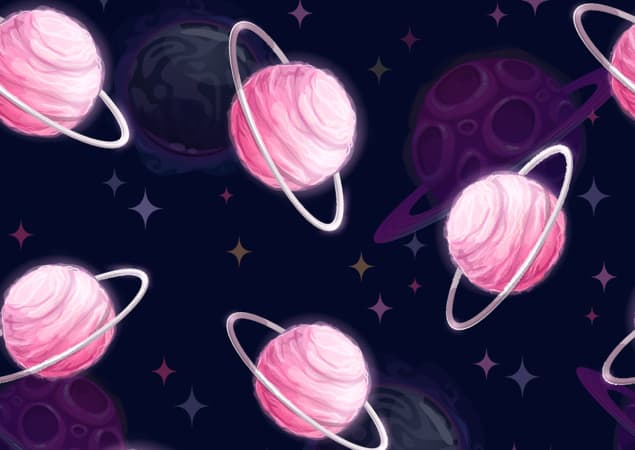Laura Hiscott muses on how candy floss is made, and an unlikely link to astrophysics

If you’ve ever read Roald Dahl’s Charlie and the Chocolate Factory, you must surely have dreamed of tearing back the silver foil from your favourite chocolate bar and winning a golden ticket. But on your tour of Willy Wonka’s factory, which of the physics-defying edible delights would you be most excited to witness? Would it be the everlasting gobstoppers that never get smaller no matter how long you suck them (surely a violation of energy conservation)? The toffee apples growing right off a toffee-apple tree? Or perhaps the rainbow drops that give you the power to spit in six different colours?
Now if Dahl had mentioned pastel-coloured clouds of sugar with the soft fluffy texture of cotton wool, you might well have thought it was another figment of his vivid imagination. Fortunately – remarkably – the marvel that is candyfloss exists in real life. It is more commonly called cotton candy in the US, and fairyfloss in Australia, but it serves the same purpose everywhere. We buy it in bags at fairs and at the seaside, stuffing it in our mouths for a few seconds of sensory magic. But what exactly is this strange substance and how do we make it? More importantly, why do we end up paying so much for what is, after all, just a spoonful of sugar?
According to Guinness World Records, confectioners were already spinning sugar in the 16th century, and recipes for the decadent treat have been found in multiple cookbooks published in the 18th century. A 1769 book called The Experienced English Housekeeper by author and entrepreneur Elizabeth Raffald offers two recipes for a “web” of spun sugar, one coloured silver and the other gold.
Since no candyfloss machine existed at the time, these recipes required hard manual labour: the sugar had to be melted and the liquid drawn out sharply by hand to form very thin strands. These filaments would instantly solidify on contact with the cold air, leaving a thread of sugar about 50 μm in diameter – roughly the same as a human hair. Do this enough times and you can create a delicate sugary web with which to decorate your ornamental desserts.
Of course, this manual method sounds difficult to master, and tedious even if you were to manage it. Fortunately for those of us with a sweet tooth that exceeds our culinary skills (guilty as charged), an American dentist called William Morrison teamed up with the confectioner John Wharton in 1897 to invent the first machine for spinning sugar. (Many have noted the irony in the fact that one of the machine’s inventors was a dentist. Perhaps it brought him more patients.)
In this device, the sugar, along with your food colouring of choice, is poured into a cylindrical component in the centre of a large bowl, where heating elements heat the sugar to above its melting point, around 190 °C. A motor sets the central component spinning very quickly, at up to a few thousand rotations per minute, generating a centrifugal force that pulls the liquid sugar towards the outside. On the outside rim of the spinning component, there are tiny holes through which the sugar shoots out into the cold air, solidifying into long threads that collect in the large bowl, ready to be wrapped around a stick and sold to the next customer.
This is actually a relatively simple set-up that you can put together at home quite cheaply (Phys. Educ. 44 420). The process of thinning the sugar out and filling it with air vastly reduces the density down to about 0.05 g/cm3 – about a thirtieth of the density of unspun sucrose (the type of sugar typically used). It is, however, still much higher than the density of our atmosphere (just over 0.001 g/cm3), so, despite their cloud-like appearance, these puffballs of sugar do not float away.
This is probably a good thing for any guardian of a child at a fairground. Kids tend to get pretty upset when they let go of their novelty helium balloons – can you imagine how upset they would be if the thing floating away were also edible and delicious? And as a parent, you might be even more distraught, given that a £2 bag of candyfloss has barely 100 g of sugar – an amount that would cost pennies in its unspun form.
But I wonder if, on a planet with a different atmosphere, candyfloss clouds might be possible. The first thing that springs to mind is the notably heavy gas sulphur hexafluoride. It is transparent and nontoxic, and the internet has videos aplenty of aluminium boats floating on it. Alas, sulphur hexafluoride is only about six times heavier than air, and still about 10 times lighter than candyfloss, so it would not float the sugar clouds unaided. Perhaps if the sugar were spun with helium instead of air it would reduce the density enough… but I’m getting carried away.
Hubble has actually spotted exoplanets that appear to have candyfloss density
If you humour me a little longer, we could go one step further and imagine a whole planet made of sweet fluff. To my surprise and delight, it turns out that the Hubble Space Telescope has actually spotted exoplanets that appear to have candyfloss density. Among these are three planets orbiting the star Kepler-51, which is about 2600 light-years from our own solar system.

Holiday hotspots for physicists
The exact reasons for their extraordinarily low density are still a mystery, and their chemical composition is as yet uncertain. In December 2019 NASA announced that astronomers observing Kepler-51b and Kepler-51d with Hubble had “found the spectra of both planets not to have any telltale chemical signatures”. As unlikely as it is that they are actually made of sugar, one can still dream.
Forget the factory. Perhaps Willy Wonka has a whole solar system somewhere in the universe. Now that would be worth winning a golden ticket for.
